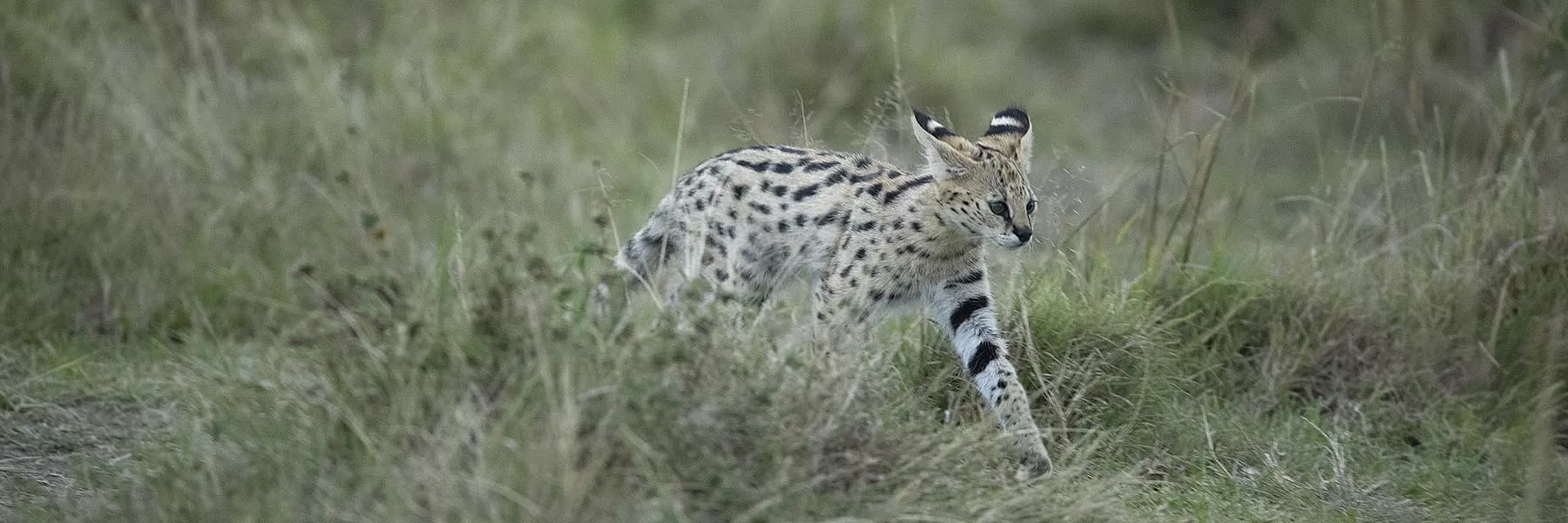Undoubtedly, Africa’s big cats are the most sought-after animals to spot during safaris. The magnificent lion and the beautiful leopard are part of the popular Big Five. On the other hand, tourists flock around to see the fast cheetah in its natural habitat.
Among all of these wild animals, the small cat species are often forgotten. These small, elusive, and rarely seen cats are dispersed in various regions of Africa. Since they are not sighted frequently, researchers have continued to learn about their ecology and behaviour.
The small cat species are equally impressive as compared to the big cats of Africa. Although they stay away from humans as well as other animals, these small cats make up some of the most beautiful creatures on the continent. Unfortunately, most are under threat, and their population is diminishing due to habitat loss, illegal trading, hunting, and similar causes.
Take a look at the seven small cat species residing in Africa:
African Caracal Cat
The caracal is the largest of Africa’s small cat species. Its name translates to secretive cat in Swahili and red cat in the Afrikaans language. It is usually found in areas such as dry woodlands, semi-deserts, and savannahs in Sub- Saharan Africa. They are also found across the Middle East and the Indian subcontinent.

Caracal
The caracal is frequently considered to be regal due to its long black ear tufts, which are its most prominent feature. It is also one of the few cats that does not have any strips or spots on its coat. Instead, this cat has a tawny red coat that is thick yet short. The colour of the coat also varies from pale reddish to yellowish-brown, brick red, and even sand-colored.
The caracal has a robust build and weighs between 11 and 20 kg. They are also one of the most powerful small cat species, as they can swim, climb trees, and jump at least 3 metres high to grab prey mid-flight. They prey on rodents, birds, and even small antelopes. Caracals are challenging to spot, mostly because they are nocturnal and only remain active at night.
African Serval Cat
The serval is a graceful and slender small cat species, called the bush cat in Africa. The serval is the same size as a caracal. This cat prefers habitats near water, like the riverine ecosystems, riparian areas, long grass savannahs, and open grasslands of North Africa. They are also located in certain regions of Morocco.

Serval cat with kitten
Thanks to their spots, the serval cat bears a passing resemblance to a cheetah and is often mistaken for one. Although they do look like cheetahs, the serval is far smaller, weighing a mere 18 kg. Aside from having a combination of stripes and spots on their coat, the serval also has large, rounded ears, which help them listen to the smallest rustle in the long grass. They also have a short tail and the longest leg-to-body ratio.
The serval uses its exceptional hearing to hunt for prey such as rodents. It detects the sound of rodents or other prey and remains motionless before pouncing on them from heights of over 2 metres. As a serval is active during the day as well as the night, spotting them becomes relatively easier.
African Wild Cat
If you spot an African wild cat in its natural environment, consider yourself lucky! The reason why it is difficult to see these small cats is that they look exactly like their domestic cousins. Since the African wild cat is also the ancestor of the domestic cat, it is often overlooked. Sometimes referred to as desert cats, these small cats are widespread in Africa, excluding the rainforest and Sahara. It is also found in the regions of the Middle East.
The African wild cat is a short-haired tabby cat with long legs and a thinner tail than a domestic cat. However, due to the diversity of habitats it lives in, this cat features different colours. The coat of the wildcat ranges from light brown to grey and even darker shades. The average African wild cat weighs around 2 to 6 kg and preys on small rodents, birds, and reptiles. They are nocturnal animals and remain active at night. If you see a pair of glowing eyes closer to the ground during an evening safari, it is usually an African wild cat trotting around.

African wild cat
Although this species of small cat is endemic in Africa, one of the biggest threats they face is interbreeding, which impacts their genetic integrity. So, it has become rare to come across a pure-bred African wildcat today.
African Golden Cat
It is believed that many people are not even aware of the existence of the African golden cat due to its extremely secretive and elusive nature. Thus, it is challenging to witness an African golden cat in the wilderness. This cat is known to reside in the rainforests of West and Central Africa.

A rare picture of the African Golden Cat
The African Golden Cat has a short tail and a coat that varies from reddish to grey colours. A few of the golden cats have spots all over their bodies, while the rest are spotted only on their inner legs and bellies. This small cat is closely related to the serval and the caracal and is two times the size of a domestic cat. They feed on rodents and birds and remain active at dawn, dusk, and night.
Aside from being solitary, the African golden cat is largely threatened by increasing habitat loss caused by deforestation and bushmeat hunting. Thus, they are classified as vulnerable on the IUCN Red List.
Jungle Cat
The Jungle Cat is also called a swamp or reed cat in Africa. Despite its name, this small cat species avoids areas such as woodlands and rainforests but instead prefers swamps, marshes, and wetlands. The jungle cat is widespread throughout South and Southeast Asia as well as the Middle East. However, in Africa, they are only found in the wetter regions of Egypt, typically around the Nile Delta.

A pair of jungle cat kittens in the wilderness
The jungle cat is twice the size of a domestic cat. It also has a similar stature as the African wildcat, except it is much taller and larger. The cat has long legs and pointed ears. The coat of the jungle cat is short-haired and plain, varying from reddish and grey to sandy yellow. Adult jungle cats have pale stripes on their legs and a ring on their black-tipped tails. Kittens often have spots or strips, which usually disappear once they mature.
Jungle cats typically feed on birds, hares, small rodents, reptiles, and fish. They are active during the day, which makes their sightings even more common.
Sand Cat
The sand cat is also known as the sand dune cat because it can handle the extremes of its desert habitat. It is found in Southwest and Central Asia, as well as North Africa. This small cat species inhabits true desert areas and adapts perfectly well to temperature fluctuations and a lack of water.

A sand cat comes out of its burrow
The sand cat weighs up to 3.4 kg and is about the size of a small domestic cat. It has short legs and a relatively long tail. On the pads of the feet, these cats have dense fur, which helps protect them from the extreme desert heat and cold temperatures and even assists them with walking on the burning sand and camouflaging. The sand cat has a light brown coat and greenish fur on the back, with stripes on the limbs.
This cat species feeds mainly on hares, insects, small desert rodents, and birds. They rarely drink water and obtain adequate moisture from their prey. Due to its secretive and shy nature, a sand cat is rarely seen.
Black-footed cat
The black-footed cat is also regarded as the smallest spotted cat. It is also the smallest of all the African cat species. This species is endemic to the southwestern areas of Southern Africa and usually favours the grasslands, savannahs, and semi-desert areas.

The little Black-footed cat
These tiny cats only weigh a maximum of 2.5 kg. They have a stocky build with fur marked with black spots, large eyes, and round ears. As its name suggests, this cat has black undersides on its feet. The face of a back-spotted cat looks similar to that of a domestic cat.
Despite their miniature size, they are one of the most successful hunters of all cat species. It preys on rodents, rabbits, and birds, and just like the sand cat, it obtains moisture from its meal. The black-footed cat is classified as vulnerable on the IUCN Red List. On top of that, they are strictly nocturnal animals and solitary in nature, as they rarely appear in front of humans.
The small cat species of Africa are just as important as the big cats. When you go on a safari drive the next time, try looking out for some of the African small cat species listed above!
If you loved reading this story, then subscribe to our blog here (it will ask to verify your email) to get inspiring travel stories and trivia delivered to your email. Stories about wildlife trivia, cultural experiences, curated luxury hotel lists, underrated places to travel, polar journeys and much more.











